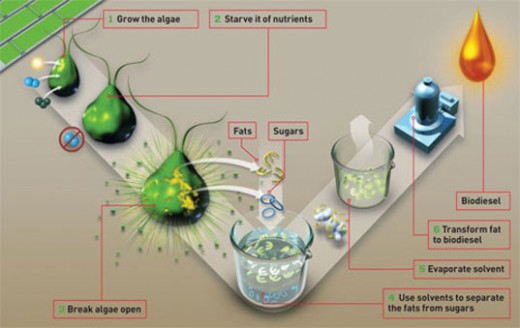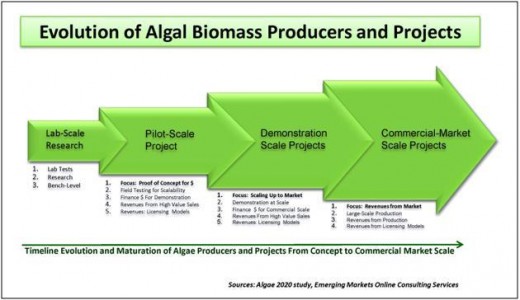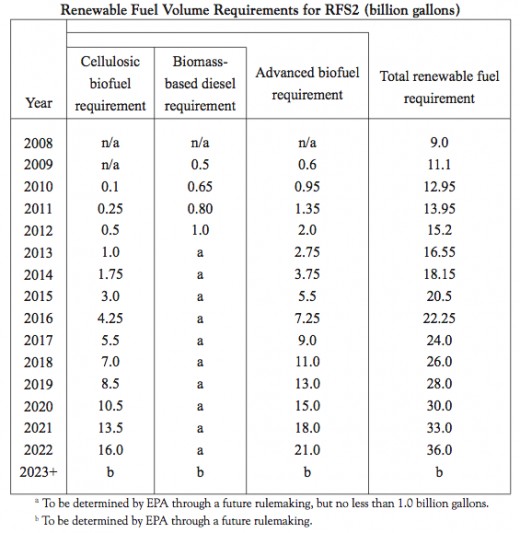Renewable Fuels to replace gas: Cellulosic Ethanol and Algae Ethanol

Which ethanol would YOU choose?
Renewable fuel production is the new source of fuel that our vehicles will be operating on in the future. Much of these renewable fuels come from the production of ethanol, and the different types of ethanol include: grain, cellulosic, and algae ethanol. Over the next ten years, the US Renewable Fuels Standard has mandated that the total amount of renewable fuels to be blended into transportation needs to be at least 36 billion gallons. What this means is that ethanol production is going to dramatically increase over the next ten years. In order to increase sustainability, the target 36 billion gallons of ethanol should be increased because the potential of these renewable ethanol resources, specifically algae related, is very high.
Grain Ethanol...you call THAT sustainable?
The three main types of ethanol that the United States is focussing on over the next decade are grain ethanol, cellulosic ethanol, and algae ethanol. Grain ethanol is currently the most produced form of renewable ethanol, and it consumes about 30% of the country’s corn crop. It is produced from foods that are transformed into simple fermentable sugars which are used as energy (Regalbuto 1).
Although it does seem to lighten the amount of GHG emissions, it is questionable whether the benefits outweigh the problems. It promotes rural development, supports farmers, and increases energy security, but there are a few caveats that go with it.
Food prices will go up because farmers are being supported, the environmental resources will deteriorate, smog will develop in heavy traffic environments, and grain ethanol actually does not reduce very much GHGs at all. (Grain Ethanol - Why Consider Food for Fuel - Richard K Perrin).Overall, it is inefficient because it does not produce a large amount of energy compared to the amount of food that is used.
Cellulosic Ethanol could help us out
Cellulosic ethanol is a renewable resource currently being researched and developed because it has the potential to alleviate our dependence on oil. It combines the above ethanol with the converting of the woody parts of trees, plants, grasses, or residues into sugars that are fermented into ethanol (Solomon 417).
Opposed to grain ethanol, which only depends on corn as an input, cellulosic ethanol is more promising in terms of sustainability. Despite the facts that it covers a large geographical area and does not have a huge return on investment yet, the vast amount of resources available and the pushing away from foreign dependence make it worth commercializing and investing in (418). Likewise, the emissions are next to nothing.
From Algae to Ethanol Fuel

Algae Ethanol is incredibly efficient
The last renewable source of ethanol is through algae that is converted into either ethanol or diesel. This method is different because the algae is extremely concentrated in lakes or ponds, and it is produced through a complex process and formed into ethanol.
However, the main problem is that there is not technology yet that can extract the energy necessary under high variable conditions (Radakovitz 2). But with the incredible density, it is postulated that a little over 20,000 square miles will be able to supply most of the current US transportation fuel demand. Because of the knowledge that technology is the one main obstacle to algae production, as shown in the picture to the right, the standards should be increased because it will encourage more research in this field of work.
Just a few more years...

These EPA fuel standards are fairly reasonable
According to the chart given in the EPA regulatory announcement that gives the renewable fuel requirements from now until 2022, it would be more sustainable to increase the requirements because the main obstacle to decreasing oil dependence is technological advances.
More emphasis needs to be put on improving technology, specifically in the field of algae related ethanol. The chart indicated that the requirement, in billions, for cellulosic biofuel, biomass-based diesel, Total Advanced biofuel, and total renewable fuel requirements for 2012 are .5, 1.0, 2.0, and 15.0, respectively (USEPA 3).
The numbers for cellulosic biofuel and biomass-based diesel should remain similar because the potential output is much lower than for other renewable sources, like algae ethanol. A higher standard requirement will greatly encourage research in this field, and with a simplified method for harvesting and producing ethanol from algae, foreign dependence on oil will dramatically lessen and CO2 emissions will be severely drop because of ethanol use instead of petroleum.
Increase the EPA standards
Overall, the yearly target of 36 billion barrels of ethanol by 2022 should be increased because the algae ethanol is dense enough to provide for the entire US fuel consumption within an area close to 35 square miles. Cellulosic and grain ethanol, require much more area and effort to get the same effects. Therefore, the extra technological push to research cheaper ways of algae production is not only suggested but necessary.

Sources
"EPA Proposes 2012 Renewable Fuel Standards and 2013 Biomass-Based Diesel Volume." EPA. Environmental Protection Agency, June 2011. Web. 15 Apr. 2012. <http://www.epa.gov/otaq/fuels/renewablefuels/420f11018.htm>.
Perrin, Richard K. Grain Ethanol - Why Consider Food for Fuel. Faculty Publications, 21 Feb. 2008. Print.
Radakovitz, Randor. "Genetic Engineering of Algae for Enhanced Biofuel Production."American Society for Microbiology 9.4 (2012): 486-501. Feb. 2010. Print.
Regalbuto, John R. "Cellulosic Biofuels−Got Gasoline?" Science. American Association for the Advancement of Science, 14 Aug. 2009. Web. 15 Apr. 2012. <http://www.sciencemag.org/content/325/5942/822.full>.
Solomon, Barry D. "Grain and Cellulosic Ethanol: History, Economics, and Energy Policy." SciVerse. Biocomplexity Program of the National Science Foundation, June 2007. 416-425.
United States Environmental Protection Agency. Office of Transportation and Air Quality. EPA Finalizes Regulations for the National Renewable Fuel Standard Program for 2010 and Beyond. Print.
BEFORE YOU GO!
If you liked this article, please don't forget to vote it up, comment, and share! And feel free to check out one of the following articles.
- From OPEC to OGEC: Natural Gas Cartel just around the corner
A Natural Gas Cartel is not only possibility but a probability. OPEC currently controls most of the rising gas prices, but we could potentially see the rise of a new OGEC natural gas cartel rise in the next 30 years. Price fluctuations are dangerous, - Understanding Sustainable Development and our future challenges
What is SD? How important is SD? EXTREMELY IMPORTANT! Don't let anyone tell you otherwise! Check out Allam Ahmed's explanation of Sustainable Development as being more than just socially acceptable, economically profitable, and environmentally friend - Investing in Sustainable Development: Mass Transit or Increasing the CAFE
Mass Transit or CAFE?? The most sustainable choice takes into account not only cost, but environmental friendliness and safety as well. Considering the fact that gasoline will only be around for the next 20-30 yeas, this is an important decision. - How the 1960's changed America
America changed immensely in the 1960's. From MLK, to JFK, to the advancement of technology, to the carefree hippies, America has been changed by the 1960's, or rather, the people and events in it. - Roman Empire vs United States - Are we heading towards the same fate?
Is the United States heading toward the same fate as the Roman Empire? CHECK OUT these similarities and then tell me what you think. - 97+ Funny things to say to Siri
You'll never guess what Siri says! I bet you haven't heard all the things that good 'ol Siri will tell you. She's quite a character! Just hold down the center button on your iPhone 4s and ask Siri any of these questions.








